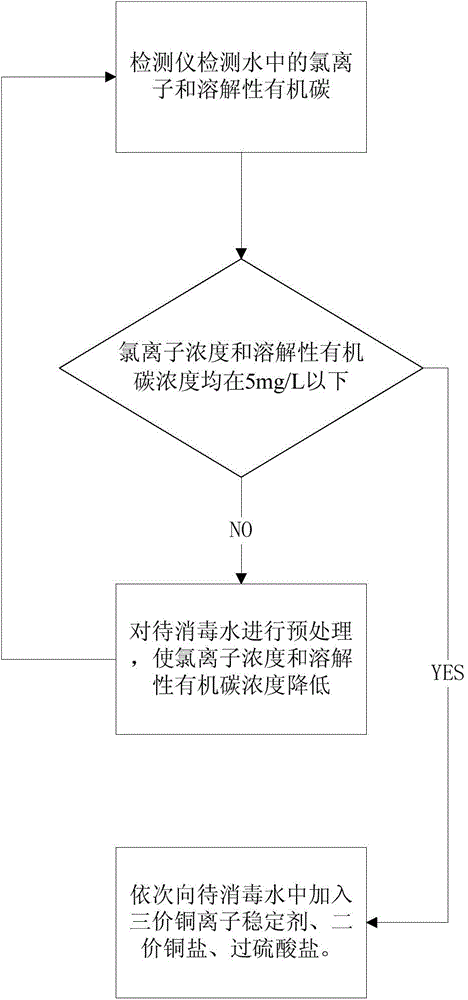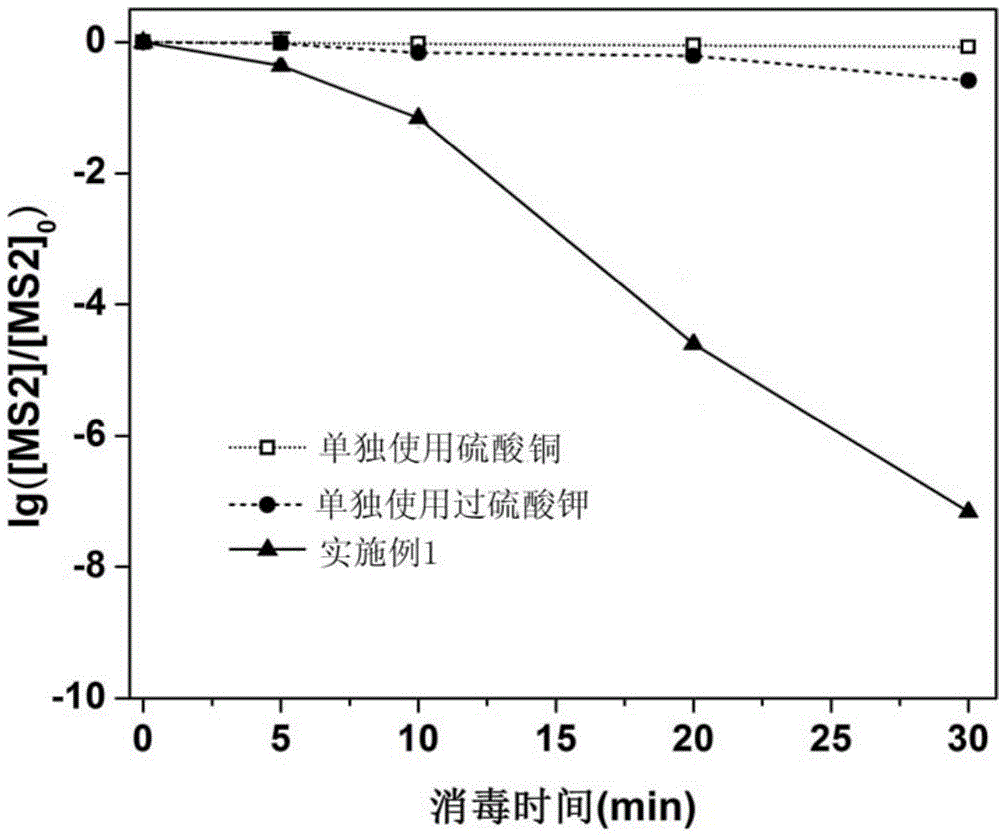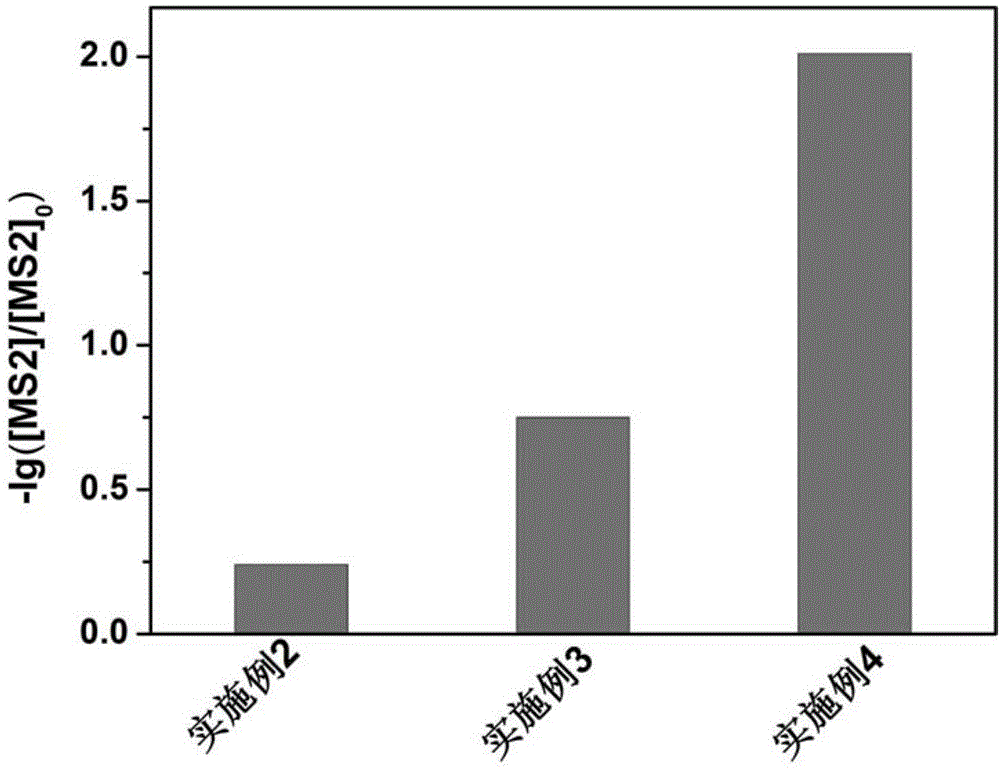Method for killing viruses in drinking water
A technology for drinking water and viruses, applied in chemical instruments and methods, water/sewage multi-stage treatment, water/sludge/sewage treatment, etc., can solve the problem of reducing the efficiency of killing viruses, increasing treatment costs, long treatment time, etc. problems, to achieve the effect of automatic management control, convenient management and operation, simple and convenient operation
- Summary
- Abstract
- Description
- Claims
- Application Information
AI Technical Summary
Problems solved by technology
Method used
Image
Examples
Embodiment 1
[0035] Use an ion chromatograph and a total organic carbon detector to detect chlorine ions and dissolved organic carbon in the water to be disinfected. If the concentration of the two does not exceed 5mg / L, no treatment is required; if the concentration of the two exceeds 5mg / L, use MIEX magnetic ion The exchange resin (Beijing Ao Ruikai Company) pretreated the water to be disinfected. When the resin concentration was 200mL / L and the contact time was 5min, the raw water containing 10mg / L chloride ion and 8mg / L dissolved organic carbon was treated, and chlorine The ion concentration is 3.5mg / L, the dissolved organic carbon concentration is 4.5mg / L, and the pH value is 6.8. On the premise that the total concentration of chloride ions and dissolved organic carbon in the water does not exceed 5mg / L, to each liter of water to be disinfected: first add 10 10 PFU MS2 bacteria solution, then add 0.5 μmol food-grade citric acid and 0.5 μmol food-grade gallic acid, and then add 10 μmol...
Embodiment 2
[0040] Use an ion chromatograph and a total organic carbon detector to detect chlorine ions and dissolved organic carbon in the water to be disinfected. If the concentration of the two does not exceed 5mg / L, no treatment is required; if the concentration of the two exceeds 5mg / L, use MIEX magnetic ion The exchange resin (Beijing Ao Ruikai Company) pretreated the water to be disinfected. When the resin concentration was 200mL / L and the contact time was 5min, the raw water containing 10mg / L chloride ion and 8mg / L dissolved organic carbon was treated, and chlorine The ion concentration is 3.5mg / L, the dissolved organic carbon concentration is 4.5mg / L, and the pH value is 6.8. On the premise that the total concentration of chloride ions and dissolved organic carbon in the water does not exceed 5mg / L, add 10 10 PFU MS2 bacteria solution, then add 0.15 μmol food-grade citric acid and 0.05 μmol food-grade gallic acid, and then add 5 μmol copper sulfate. After these three agents are m...
Embodiment 3
[0042] Use an ion chromatograph and a total organic carbon detector to detect chlorine ions and dissolved organic carbon in the water to be disinfected. If the concentration of the two does not exceed 5mg / L, no treatment is required; if the concentration of the two exceeds 5mg / L, use MIEX magnetic ion The exchange resin (Beijing Ao Ruikai Company) pretreated the water to be disinfected. When the resin concentration was 200mL / L and the contact time was 5min, the raw water containing 10mg / L chloride ion and 8mg / L dissolved organic carbon was treated, and chlorine The ion concentration is 3.5mg / L, the dissolved organic carbon concentration is 4.5mg / L, and the pH value is 6.8. On the premise that the total concentration of chloride ions and dissolved organic carbon in the water does not exceed 5mg / L, add 10 10 PFU MS2 bacteria solution, then add 0.15 μmol food-grade citric acid and 0.05 μmol food-grade gallic acid, and then add 15 μmol copper sulfate. After these three agents are ...
PUM
 Login to View More
Login to View More Abstract
Description
Claims
Application Information
 Login to View More
Login to View More - R&D
- Intellectual Property
- Life Sciences
- Materials
- Tech Scout
- Unparalleled Data Quality
- Higher Quality Content
- 60% Fewer Hallucinations
Browse by: Latest US Patents, China's latest patents, Technical Efficacy Thesaurus, Application Domain, Technology Topic, Popular Technical Reports.
© 2025 PatSnap. All rights reserved.Legal|Privacy policy|Modern Slavery Act Transparency Statement|Sitemap|About US| Contact US: help@patsnap.com



